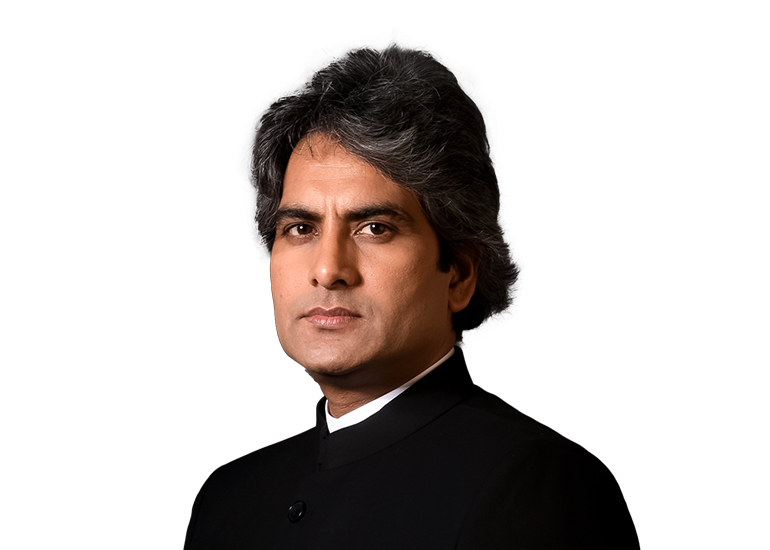Q] It has been a year since you started your show ‘Black and White’ on Aaj Tak. How has the journey been?
It has been a very pleasant and satisfying journey. When I first came to Aaj Tak, which is one of the biggest and most prestigious platforms in the country, I was a little nervous, as I didn’t know how my viewers would accept this new show.
It felt like I was starting a new journey. It was like attempting to make Sholay 2, and hoping that it becomes equally successful as the first part.
Now when I go out in public, people tell me how much they love the show, and I am happy that the audience has accepted it.
Q] You are also hosting Seedhi Baat for the channel. How is that going?
I am enjoying hosting both shows, and I hope that the audience is happy to see me in this new format.
Q] You have been a part of newsrooms for close to three decades. What changes have newsrooms gone through during this time?
The biggest difference is technology. Thirty years ago when I first started my career, it was a completely different era.
In 1999, when I was covering the Kargil war, the biggest challenge was - how to get the footage from Kargil to Delhi. I had interviewed Captain Vikram Batra at that time, and by the time the interview went on air, the Captain was martyred.
Today, there is a huge shift from a tech standpoint. We can have a PCR at one location, and a reporter and anchor at other locations. Technology has made everything easier in our business.
The biggest challenge that came after this tech empowerment of newsrooms was catering to so many generations at one go. Also, technology has empowered both broadcasters and viewers - I can do a live broadcast from my studio, but so can our viewers from their homes.
News today is first viewed on social media before television channels. Social platforms have become a parallel source of information, and they have made our work challenging. This is a time when you have to continuously innovate and reimagine your formats.

Q] It’s said that there is less news and more views on TV. Your take?
All the changes that you notice in TV news today come from the likes and dislikes of viewers. The primetime show at 9 PM is the editorial page of a news channel. It informs people about the meaning and significance of a news piece and how it affects them.
If you show news without any analysis, it will be insufficient, as people already have the information. What is left to be told is, ‘Why is this happening?’
Today, tech companies, whether it is Twitter, Facebook, Instagram, etc., are giving you a platform to convey your opinion. You can share your views with people in different formats, through your videos, tweets, etc. So, you can guess how eager our viewers are to hear opinions.
If views are removed, viewers will only get to see speed news for 24 hours - 100 news in 5 minutes, and they will never understand the context of any news stories.
Q] When you move on from a long stint, like your previous one, how do you adjust to the culture of a new place? Is it easy? How has your experience been at Aaj Tak so far?
I see myself as a player who plays on different pitches. The India Today Group is prestigious, so it is a matter of pride for anyone to work here. The best thing about this media company is that it is a democratic newsroom, and people with different ideologies work together. No one dominates anyone. We make content in a professional manner.
The engine behind a news channel is the editorial team, but there are other teams behind it. The liberty and professional support that a journalist requires for content creation are available here. The platform has millions of viewers, especially through its YouTube channel, which happens to be the most subscribed news channel in the world. When you get this kind of exposure, your content is bound to become successful.
Q] It’s said that in today’s TV journalism, we have forgotten to ask tough questions to people in power. News has just become a medium for amplification and nothing more. Your views?
Many viewers say that you cannot ask the Prime Minister tough questions, but if you see my interviews with the PM, you will know that I have always asked him the relevant questions. In the last interview that I did with the Prime Minister, which was just before the last election, I had asked him about unemployment and other issues.
Similarly, people say we don’t ask tough questions to top ministers like Amit Shah. You can watch all my interviews with him and tell me which of those are not tough questions.
Most people who propagate such opinions are working for some political party. They make a narrative that tough questions are not being asked. If I may ask about the opposition to those who say that people in power don’t speak up - when did Rahul Gandhi, Sonia Gandhi, or Nitish Kumar last give an interview?
I do not believe in doing disrespectful interviews. If a person comes to me as a guest, he has the right to say what he wants to say.
When you interview for an hour, only a portion of it is shown on social media and misinformation is spread by vested interests, just to malign the journalist. Dealing with misinformation is the biggest challenge for journalists today.























